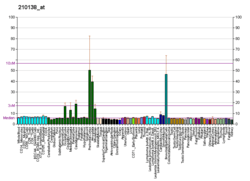RGS20
Regulator of G-protein signaling 20 is a protein that in humans is encoded by the RGS20 gene.[5][6][7]
Regulator of G protein signaling (RGS) proteins are regulatory and structural components of G protein-coupled receptor complexes. RGS proteins are GTPase-activating proteins for Gi (see GNAI1; MIM 139310) and Gq (see GNAQ; MIM 600998) class G-alpha proteins. They accelerate transit through the cycle of GTP binding and hydrolysis and thereby accelerate signaling kinetics and termination.[supplied by OMIM][7]
In melanocytic cells RGS20 gene expression may be regulated by MITF.[8]
Interactions
RGS20 has been shown to interact with GNAO1[9] and GNAZ.[5][10]
References
- 1 2 3 GRCh38: Ensembl release 89: ENSG00000147509 - Ensembl, May 2017
- 1 2 3 GRCm38: Ensembl release 89: ENSMUSG00000002459 - Ensembl, May 2017
- ↑ "Human PubMed Reference:".
- ↑ "Mouse PubMed Reference:".
- 1 2 Glick JL, Meigs TE, Miron A, Casey PJ (Nov 1998). "RGSZ1, a Gz-selective regulator of G protein signaling whose action is sensitive to the phosphorylation state of Gzalpha". J Biol Chem. 273 (40): 26008–13. doi:10.1074/jbc.273.40.26008. PMID 9748279.
- ↑ Wang J, Ducret A, Tu Y, Kozasa T, Aebersold R, Ross EM (Nov 1998). "RGSZ1, a Gz-selective RGS protein in brain. Structure, membrane association, regulation by Galphaz phosphorylation, and relationship to a Gz gtpase-activating protein subfamily". J Biol Chem. 273 (40): 26014–25. doi:10.1074/jbc.273.40.26014. PMID 9748280.
- 1 2 "Entrez Gene: RGS20 regulator of G-protein signalling 20".
- ↑ Hoek KS, Schlegel NC, Eichhoff OM, et al. (2008). "Novel MITF targets identified using a two-step DNA microarray strategy". Pigment Cell Melanoma Res. 21 (6): 665–76. doi:10.1111/j.1755-148X.2008.00505.x. PMID 19067971.
- ↑ Pagano, Mario; Jordan J Dedrick; Neves Susana R; Nguyen Tracy; Iyengar Ravi (Jun 2008). "Galphao/i-stimulated proteosomal degradation of RGS20: a mechanism for temporal integration of Gs and Gi pathways". Cell. Signal. England. 20 (6): 1190–7. doi:10.1016/j.cellsig.2008.02.008. ISSN 0898-6568. PMC 3107604. PMID 18407463.
- ↑ Nagahama, Masami; Usui Shihomi; Shinohara Takashi; Yamaguchi Tomohiro; Tani Katsuko; Tagaya Mitsuo (Dec 2002). "Inactivation of Galpha(z) causes disassembly of the Golgi apparatus". J. Cell Sci. England. 115 (Pt 23): 4483–93. doi:10.1242/jcs.00093. ISSN 0021-9533. PMID 12414994.
Further reading
- Barker SA, Wang J, Sierra DA, Ross EM (2002). "RGSZ1 and Ret RGS: two of several splice variants from the gene RGS20". Genomics. 78 (3): 223–9. doi:10.1006/geno.2001.6659. PMID 11735229.
- Sierra DA, Gilbert DJ, Householder D, et al. (2002). "Evolution of the regulators of G-protein signaling multigene family in mouse and human". Genomics. 79 (2): 177–85. doi:10.1006/geno.2002.6693. PMID 11829488.
- Nixon AB, Grenningloh G, Casey PJ (2002). "The interaction of RGSZ1 with SCG10 attenuates the ability of SCG10 to promote microtubule disassembly". J. Biol. Chem. 277 (20): 18127–33. doi:10.1074/jbc.M201065200. PMID 11882662.
- Wang Y, Ho G, Zhang JJ, et al. (2003). "Regulator of G protein signaling Z1 (RGSZ1) interacts with Galpha i subunits and regulates Galpha i-mediated cell signaling". J. Biol. Chem. 277 (50): 48325–32. doi:10.1074/jbc.M206116200. PMID 12379657.
- Nagahama M, Usui S, Shinohara T, et al. (2003). "Inactivation of Galpha(z) causes disassembly of the Golgi apparatus". J. Cell Sci. 115 (Pt 23): 4483–93. doi:10.1242/jcs.00093. PMID 12414994.
- Strausberg RL, Feingold EA, Grouse LH, et al. (2003). "Generation and initial analysis of more than 15,000 full-length human and mouse cDNA sequences". Proc. Natl. Acad. Sci. U.S.A. 99 (26): 16899–903. Bibcode:2002PNAS...9916899M. doi:10.1073/pnas.242603899. PMC 139241. PMID 12477932.
- Fischer T, De Vries L, Meerloo T, Farquhar MG (2003). "Promotion of G alpha i3 subunit down-regulation by GIPN, a putative E3 ubiquitin ligase that interacts with RGS-GAIP". Proc. Natl. Acad. Sci. U.S.A. 100 (14): 8270–5. Bibcode:2003PNAS..100.8270F. doi:10.1073/pnas.1432965100. PMC 166218. PMID 12826607.
- Ota T, Suzuki Y, Nishikawa T, et al. (2004). "Complete sequencing and characterization of 21,243 full-length human cDNAs". Nat. Genet. 36 (1): 40–5. doi:10.1038/ng1285. PMID 14702039.
- Xu GY, Hum WT, Sukits SF, et al. (2004). "1H, 13C and 15N resonance assignments of human RGSZ1". J. Biomol. NMR. 28 (4): 409–10. doi:10.1023/B:JNMR.0000015374.29659.f9. PMID 14872136.
- Gerhard DS, Wagner L, Feingold EA, et al. (2004). "The status, quality, and expansion of the NIH full-length cDNA project: the Mammalian Gene Collection (MGC)". Genome Res. 14 (10B): 2121–7. doi:10.1101/gr.2596504. PMC 528928. PMID 15489334.
- Rual JF, Venkatesan K, Hao T, et al. (2005). "Towards a proteome-scale map of the human protein-protein interaction network". Nature. 437 (7062): 1173–8. Bibcode:2005Natur.437.1173R. doi:10.1038/nature04209. PMID 16189514.
- Ajit SK, Ramineni S, Edris W, et al. (2007). "RGSZ1 interacts with protein kinase C interacting protein PKCI-1 and modulates mu opioid receptor signaling". Cell. Signal. 19 (4): 723–30. doi:10.1016/j.cellsig.2006.09.008. PMID 17126529.
- Ewing RM, Chu P, Elisma F, et al. (2007). "Large-scale mapping of human protein-protein interactions by mass spectrometry". Mol. Syst. Biol. 3 (1): 89. doi:10.1038/msb4100134. PMC 1847948. PMID 17353931.
This article is issued from
Wikipedia.
The text is licensed under Creative Commons - Attribution - Sharealike.
Additional terms may apply for the media files.




